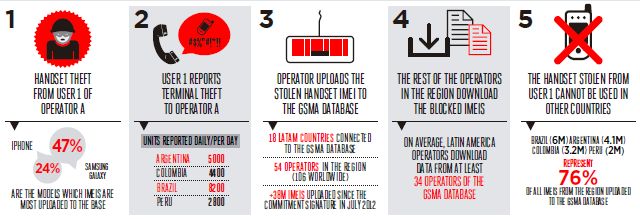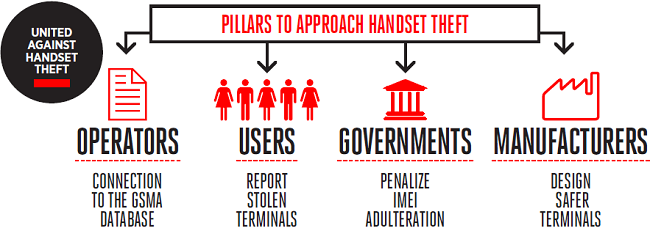In recent years, handset theft has grown strongly due to the expansion in the adoption of mobile phones, especially smartphones. Public and private sectors are working jointly and collaboratively to prevent the activation of stolen devices, thereby restraining the black market and crimes linked to this phenomenon..
Industry’s contribution to combat handset theft
In order to support regional initiatives, and collaborate in the fight against handset theft, thirteen groups of mobile operators in Latin America have committed to block the use of stolen devices. In July 2012, at a meeting of the Chief Regulatory Officers Group for Latin America (CROG Latin America), the heads of public policy of mobile operators in the region agreed upon steps to start exchanging information through the GSMA Database.
Since the agreement’s signature in 2012 up to date, the GSMA Database registers 44 countries worldwide sharing information on stolen devices on a daily basis. 140 operators are connected to the Database. From a regional perspective, Latin America registers 18 connected countries that represent 50 Operators sharing information.
The stolen handset Database is the most robust mechanism available worldwide, with regards to global efforts on tackling this scourge, which has come to take human lives in theft situations.
Sharing information to prevent handset reactivation
To actually combat this issue, it is essential to share the information among operators within the same country as well as enabling the possibility to do so regionally, as to prevent stolen handsets from being used in a different country.
A simple process to prevent trafficking of stolen handsets. Schematic view of terminals blocking
Handsets targeted by criminals
Handset theft related offenses are growing at a very fast pace in the region. For example, in Colombia it is estimated that close to 1 million devices were stolen in 2013, about 2,700 per month, while only 18,000 theft reports were registered. In Argentina the number of stolen equipment raises up to 6,500 per day, 35% of the victims being children or teenagers. In Ecuador the number of stolen terminals reaches a 1,400 daily average. Meanwhile in Brazil this number climbs to 2,500.
These issues have great media impact due to related crimes and murders, which led to greater concern among national authorities.
Combating theft: a duty of all
Combating handset theft fully and effectively requires a coordinated approach in accordance with each pillar responsibility: USERS, OPERATORS, REGULATORS AND MANUFACTURERS. Succeeding in reducing this scourge will not be possible without a joint effort.
Empowering users: Device Check System
The IMEI Device Check is a real-time service that provides access to the global IMEI database. It enables users, recyclers, mobile network operators and law enforcement agencies to identify suspect devices, minimise loss and combat crime. Law enforcement agencies and government bodies can use this tool to identify the status of the devices encountered during day-to-day operations and to return the blacklisted devices to the proper mobile operator/provider. See the brochure for more information.
Related Resources
- Anatel y la GSMA celebran la implementación de IMEI Device Check en México
- En un 70 por ciento ha disminuido robo de celulares en Honduras – News Article – El Heraldo (Honduras)
- GSMA Input to CITEL on Handset Theft – Information Document – GSMA
- CITEL Resolution on Handset Theft – Document – Delegation of Colombia
- Mexican Government and operators sign an agreement against mobile terminals theft – Article – GSMA LA
- Latin American Mobile Operators commit to combat mobile device theft – Press Release – GSMA LA
- IMEI DataBase – Website – GSMA
- Mobile Phone Theft in Latam: The example of Costa Rica and the need of coordination among operators – Article – GSMA LA
- Announcement by the Government of Honduras (video)


